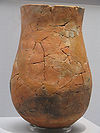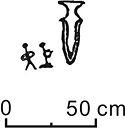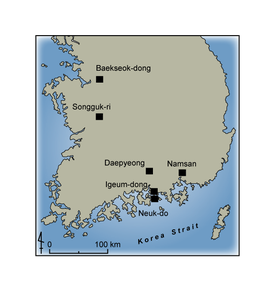
Prehistoric Korea
Encyclopedia

Korean Peninsula
The Korean Peninsula is a peninsula in East Asia. It extends southwards for about 684 miles from continental Asia into the Pacific Ocean and is surrounded by the Sea of Japan to the south, and the Yellow Sea to the west, the Korea Strait connecting the first two bodies of water.Until the end of...
for which written records did not exist. It, however, constitutes the greatest segment of the Korean past and is the major object of study in the disciplines of archaeology
Archaeology
Archaeology, or archeology , is the study of human society, primarily through the recovery and analysis of the material culture and environmental data that they have left behind, which includes artifacts, architecture, biofacts and cultural landscapes...
, geology
Geology
Geology is the science comprising the study of solid Earth, the rocks of which it is composed, and the processes by which it evolves. Geology gives insight into the history of the Earth, as it provides the primary evidence for plate tectonics, the evolutionary history of life, and past climates...
, and palaeontology.
Periodisation
Historians in Korea use the Three-age systemThree-age system
The three-age system in archaeology and physical anthropology is the periodization of human prehistory into three consecutive time periods, named for their respective tool-making technologies:* The Stone Age* The Bronze Age* The Iron Age-Origin:...
to classify Korean prehistory.
The three age system was applied during of the post-Japanese colonisation period as a way to expose the claims of Japanese colonial archaeologists who insisted that, unlike Japan, Korea had "no Bronze Age" as erroneous.
There are some problems with the three-age-system applied to the situation in Korea:
- The periodisation scheme used by Korean archaeologists proposes that the Neolithic began in 8000 BCE and lasted until 1500 BCE. This is despite the fact that palaeoethnobotanicalPaleoethnobotanyPaleoethnobotany, also known as archaeobotany in European academic circles, is the archaeological sub-field that studies plant remains from archaeological sites...
studies indicate that the first bona fide cultivation did not begin until circa 3500 BCE. - The Korean Bronze Age is taken to begin around 800 BC, ending around 300 BCE. This periodisation has been criticized, because bronze technology was not adopted in the southern Korean PeninsulaKorean PeninsulaThe Korean Peninsula is a peninsula in East Asia. It extends southwards for about 684 miles from continental Asia into the Pacific Ocean and is surrounded by the Sea of Japan to the south, and the Yellow Sea to the west, the Korea Strait connecting the first two bodies of water.Until the end of...
until circa 700 BC, and the archaeological record indicates that bronze objects were not consumed in relatively large numbers until after 400 BCE.
Geological prehistory
Geological prehistory is the most ancient part of Korea's past. The oldest rocks in Korea date to the PrecambrianPrecambrian
The Precambrian is the name which describes the large span of time in Earth's history before the current Phanerozoic Eon, and is a Supereon divided into several eons of the geologic time scale...
. The Yeoncheon System corresponds to the Precambrian and is distributed around Seoul extending out to Yeoncheon-gun in a northeasterly direction. It is divided into upper and lower parts and is composed of biotite-quartz-feldspar schist, marble, lime-silicate, quartzite, graphite schist, mica-quartz-feldspar schist, mica schist, quartzite, augen gneiss, and garnet-bearing granitic gneiss. The Korean Peninsula had an active geological prehistory through the Mesozoic
Mesozoic
The Mesozoic era is an interval of geological time from about 250 million years ago to about 65 million years ago. It is often referred to as the age of reptiles because reptiles, namely dinosaurs, were the dominant terrestrial and marine vertebrates of the time...
, when many mountain ranges were formed, and slowly became more stable in the Cenozoic
Cenozoic
The Cenozoic era is the current and most recent of the three Phanerozoic geological eras and covers the period from 65.5 mya to the present. The era began in the wake of the Cretaceous–Tertiary extinction event at the end of the Cretaceous that saw the demise of the last non-avian dinosaurs and...
. Major Mesozoic formations include the Gyeongsang Supergroup, a series of geological episodes in which biotite granites, shales, sandstones, conglomerates andesite, basalt, rhyolite, and tuff that were laid down over most of present-day Gyeongsang-do Province.
The remainder of this article describes the human
Homo (genus)
Homo is the genus that includes modern humans and species closely related to them. The genus is estimated to be about 2.3 to 2.4 million years old, evolving from australopithecine ancestors with the appearance of Homo habilis....
prehistory of the Korean Peninsula.
Paleolithic
The origins of this period are an open question but the antiquity of hominid occupation in Korea may date to as early as 500,000 BCE. Yi and Clark are somewhat skeptical of dating the earliest occupation to the Lower Palaeolithic.At Seokjang-ri, an archaeological site near Gongju, Chungcheongnam-do Province, artifacts that appear to have an affinity with Lower Paleolithic stone tools were unearthed in the lower levels of the site. Bifacial chopper or chopping-tools were also excavated. Hand axes and cleavers produced by men in later eras were also uncovered.
From Jeommal Cave a tool, possibly for hunting, made from the radius of a hominid was unearthed, along with hunting and food preparation tools of animal bones. The shells of nuts collected for nourishment were also uncovered.
In Seokjang-ri and in other riverine sites, stone tools were found with definite traces of Palaeolithic tradition, made of fine-grain rocks such as quartzite, porphyry, obsidian, chert, and felsite manifest Acheulian, Mousteroid, and Levalloisian characteristics. Those of the chopper tradition are of simpler in shape and chipped from quartz and pegmatite. Seokjang-ri's middle layers showed that humans hunted with these bola or missile stones.
During the Middle Paleolithic Period, humans dwelt in caves at the Jeommal Site near Jecheon and at the Durubong Site near Cheongju. From these two cave sites, fossil remains of rhinoceros, cave bear, brown bear, hyena and numerous deer (Pseudaxi gray var.), all extinct species, were excavated.
The earliest radiocarbon dates for the Paleolithic indicate the antiquity of occupation on the Korean peninsula is between 40,000 and 30,000 BP.
From an interesting habitation site at Locality 1 at Seokjang-ri, excavators claim that they excavated some human hairs of Mongoloid origin along with limonitic and manganese pigments near and around a hearth, as well as animal figurines such as a dog, tortoise and bear made of rock. Reports claim that these were carbon dated to some 20,000 years ago.
The Palaeolithic ends when pottery production begins c 8000 BCE.
Jeulmun Pottery Period

Korean pottery
Korean ceramic history begins with the oldest earthenware from around 8000 BC.-Three Kingdoms pottery:-Goryeo Dynasty porcelain:The Goryeo Dynasty achieved the unification of the Later Three Kingdoms under King Taejo...
dates back to c 8000 BCE or before. This pottery is known as Yungimun Pottery (ko:융기문토기) is found in much of the peninsula. Some examples of Yungimun-era sites are Gosan-ri in Jeju-do
Jeju-do
Jeju-do is the only special autonomous province of South Korea, situated on and coterminous with the country's largest island. Jeju-do lies in the Korea Strait, southwest of Jeollanam-do Province, of which it was a part before it became a separate province in 1946...
and Ubong-ri in Greater Ulsan
Ulsan
Ulsan , officially the Ulsan Metropolitan City, is South Korea's seventh largest metropolis with a population of over 1.1 million. It is located in the south-east of the country, neighboring Busan to the south and facing Gyeongju to the north and the Sea of Japan to the east.Ulsan is the...
. Jeulmun or Comb-pattern Pottery (즐문토기) is found after 7000 BC, and pottery with comb-patterns over the whole vessel is found concentrated at sites in west–central Korea between 3500–2000 BC, a time when a number of settlements such as Amsa-dong
Amsa-dong
Amsa-dong is a dong, neighbourhood of Gangdong-gu in Seoul, South Korea. The dong is well-known for the Amsa-dong Preshistoric Settlement Site in which Neolithic remains were excavated after a large number of diagonal-line patterned earthenware underneath the earth were accidentally uncovered by a...
and Chitam-ni existed. Jeulmun pottery bears basic design and form similarities to that of the Russian Maritime Province, Mongolia
Mongolia
Mongolia is a landlocked country in East and Central Asia. It is bordered by Russia to the north and China to the south, east and west. Although Mongolia does not share a border with Kazakhstan, its western-most point is only from Kazakhstan's eastern tip. Ulan Bator, the capital and largest...
, and the Amur and Sungari River basins of Manchuria
Manchuria
Manchuria is a historical name given to a large geographic region in northeast Asia. Depending on the definition of its extent, Manchuria usually falls entirely within the People's Republic of China, or is sometimes divided between China and Russia. The region is commonly referred to as Northeast...
and the Jōmon culture in Japan.
The people of the Jeulmun practiced a broad spectrum economy of hunting, gathering, foraging, and small-scale cultivation of wild plants. It was during the Jeulmun that the cultivation of millet and rice was introduced to the Korean peninsula from the Asian continent.

Mumun Pottery Period

Mumun pottery period
The Mumun pottery period is an archaeological era in Korean prehistory that dates to approximately 1500-300 BC This period is named after the Korean name for undecorated or plain cooking and storage vessels that form a large part of the pottery assemblage over the entire length of the period, but...
(c 1500–300 BCE). People in southern Korea adopted intensive dry-field and paddy-field
Paddy field
A paddy field is a flooded parcel of arable land used for growing rice and other semiaquatic crops. Paddy fields are a typical feature of rice farming in east, south and southeast Asia. Paddies can be built into steep hillsides as terraces and adjacent to depressed or steeply sloped features such...
agriculture with a multitude of crops in the Early Mumun Period (1500–850 BCE). The first societies led by chiefs emerged in the Middle Mumun (850–550 BCE), and the first ostentatious elite burials can be traced to the Late Mumun (c 550–300 BCE). Bronze production began in the Middle Mumun and became increasingly important in Mumun ceremonial and political society after 700 BCE. The Mumun is the first time that villages rose, became large, and then fell: some important examples include Songgung-ni, Daepyeong
Daepyeong
Daepyeong is the name of a complex prehistoric archaeological site located in the Nam River valley near Jinju in South Gyeongsang Province, South Korea...
, and Igeum-dong. The increasing presence of long-distance exchange, an increase in local conflicts, and the introduction of bronze and iron metallurgy are trends denoting the end of the Mumun around 300 BCE.
Bronze Age
The Bronze Age reaches Korea from about 800 BCE, but Bronze metallurgy does not become widespread until shortly before the arrival of ferrous metallurgy around the 4th century BCE.Iron Age
The Korean Iron Age begins in the 400 BCE. This corresponds to the later stage of GojoseonGojoseon
Gojoseon was an ancient Korean kingdom. Go , meaning "ancient," distinguishes it from the later Joseon Dynasty; Joseon, as it is called in contemporaneous writings, is also romanized as Chosŏn....
, the Jin state period in the south, and the Proto–Three Kingdoms period of the 1st to 4th century CE.
The period that begins after 300 BCE can be described as 'protohistoric', a time when some documentary sources seem to describe socieites in the Korean peninsula. The historical polities described in ancient texts such as the Samguk Sagi are an example. The Korean Protohistoric lasts until about the 4th to 5th centuries, when the Korean Three Kingdoms adopt Chinese writing, leaving early records in Old Korean
Old Korean
Old Korean corresponds to the Korean language from the beginning of Three Kingdoms of Korea to the latter part of the Unified Silla, of which period is roughly from 1 AD to 1000 AD. There are many theories to differentiate the Korean language histories. It is distinct from Proto-Korean , which is...
.
Mythological prehistory
Ancient texts such as the Samguk SagiSamguk Sagi
Samguk Sagi is a historical record of the Three Kingdoms of Korea: Goguryeo, Baekje and Silla. The Samguk Sagi is written in Classical Chinese and its compilation was ordered by Goryeo's King Injong Samguk Sagi (History of the Three Kingdoms) is a historical record of the Three Kingdoms of...
, Samguk Yusa
Samguk Yusa
Samguk Yusa, or Memorabilia of the Three Kingdoms, is a collection of legends, folktales, and historical accounts relating to the Three Kingdoms of Korea , as well as to other periods and states before, during, and after the Three Kingdoms period.The text was written in Classical Chinese, which was...
, Book of Later Han
Book of Later Han
The Book of the Later Han or the History of the Later Han is one of the official Chinese historical works which was compiled by Fan Ye in the 5th century, using a number of earlier histories and documents as sources...
, and others have sometimes been used to interpret segments of Korean prehistory. The most well-known version of the founding legend that relates the origins of the Korean ethnicity explains that Dangun
Dangun
Dangun Wanggeom was the legendary founder of Gojoseon, the first Korean kingdom, around present-day Liaoning, Manchuria, and the Korean Peninsula. He is said to be the "grandson of heaven", and to have founded the kingdom in 2333 BC...
came to the earth in 2333 BCE, while however, no evidence has been found that supports whatever facts may lie beneath this myth. A significant amount of historical inquiry in the 20th century was devoted to the interpretation of the accounts of Gojoseon
Gojoseon
Gojoseon was an ancient Korean kingdom. Go , meaning "ancient," distinguishes it from the later Joseon Dynasty; Joseon, as it is called in contemporaneous writings, is also romanized as Chosŏn....
(?–108 BCE), Gija Joseon
Gija Joseon
Gija Joseon describes the period after the alleged arrival of Gija in the northwest of Korean peninsula. It was considered by most of the Chinese and the Korean scholars as a part of the Gojoseon period of Korean history...
(?–194 BCE, currently its existence in controversy), Wiman Joseon
Wiman Joseon
Wiman Joseon was part of the Gojoseon period of Korean history. It began with Wiman's seizure of the throne from Gojoseon's King Jun and ended with the death of King Ugeo who was a grandson of Wiman.-Founding:...
(194–108 BCE), and others mentioned in historical texts.
See also
- List of archaeological periods (Korea)
- Dongsam-dong Shell MiddenDongsam-dong Shell MiddenDongsam-dong Shell Midden or Shell Mound is located on the west coast of Yeong-do Island in Dongsam-dong, Yeongdo-gu, Busan Metropolitan City, the Republic of Korea....
- Bangudae PetroglyphsBangudae PetroglyphsThe Bangudae Petroglyphs are located in Daegok-ri, Ulsan, South Korea. This site of substantial engraved rock art was rediscovered in 1971 and was designated as the 285th National Treasure of South Korea on June 23, 1995. The petroglyphs sit in an isolated forested area almost completely enclosed...
Further reading
- Ahn, Jae-ho. (2000) Hanguk Nonggyeongsahoe-ui Seongnip [The Formation of Agricultural Society in Korea]. Hanguk Kogo-Hakbo [Journal of the Korean Archaeological Society] 43: 41–66. ISSN 1015-373X
- Bale, Martin T. (2001) Archaeology of Early Agriculture in Korea: An Update on Recent Developments. Bulletin of the Indo-Pacific Prehistory Association 21(5): 77–84. ISSN 0156-1316
- Bale, Martin T and Min-jung Ko (2006) Craft Production and Social Change in Mumun Period Korea. Asian Perspectives 45(2): 159–187.
- Choe, C P and Martin T Bale (2002) Current Perspectives on Settlement, Subsistence, and Cultivation in Prehistoric Korea. Arctic Anthropology 39(1–2): 95–121. ISSN 0066-6939
- Crawford, Gary W and Gyoung–Ah Lee (2003) Agricultural Origins in the Korean Peninsula. Antiquity 77(295): 87–95.
- Im, Hyo-jae (2000) Hanguk Sinseokgi Munhwa [Neolithic Culture in Korea]. Jibmundang, Seoul. ISBN 89-303-0257-2
- Kim, Jangsuk (2003) Land-use Conflict and the Rate of Transition to Agricultural Economy: A Comparative Study of Southern Scandinavia and Central-western Korea. Journal of Archaeological Method and Theory 10(3): 277–321.
- Kuzmin, Yaroslav V (2006) Chronology of the Earliest Pottery in East Asia: Progress and Pitfalls. Antiquity 80: 362–371.
- Nelson, Sarah M (1993) The Archaeology of Korea. Cambridge University Press, Cambridge. ISBN 0-521-40783-4
- Nelson, Sarah M (1999) Megalithic Monuments and the Introduction of Rice into Korea. In The Prehistory of Food: Appetites for Change, edited by C. Gosden and J. Hather, pp. 147–165. Routledge, London.
- Rhee, S N and M L Choi (1992) Emergence of Complex Society in Prehistoric Korea. Journal of World Prehistory 6: 51–95.

